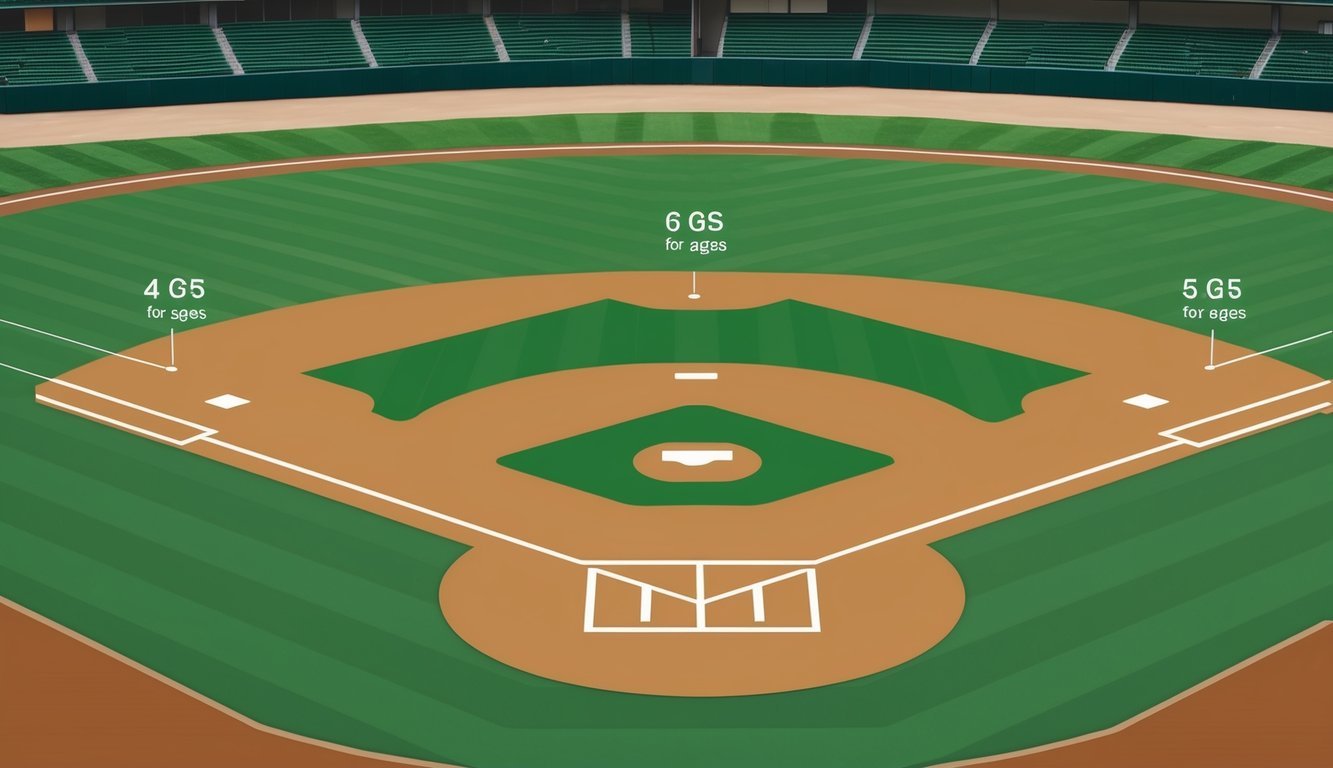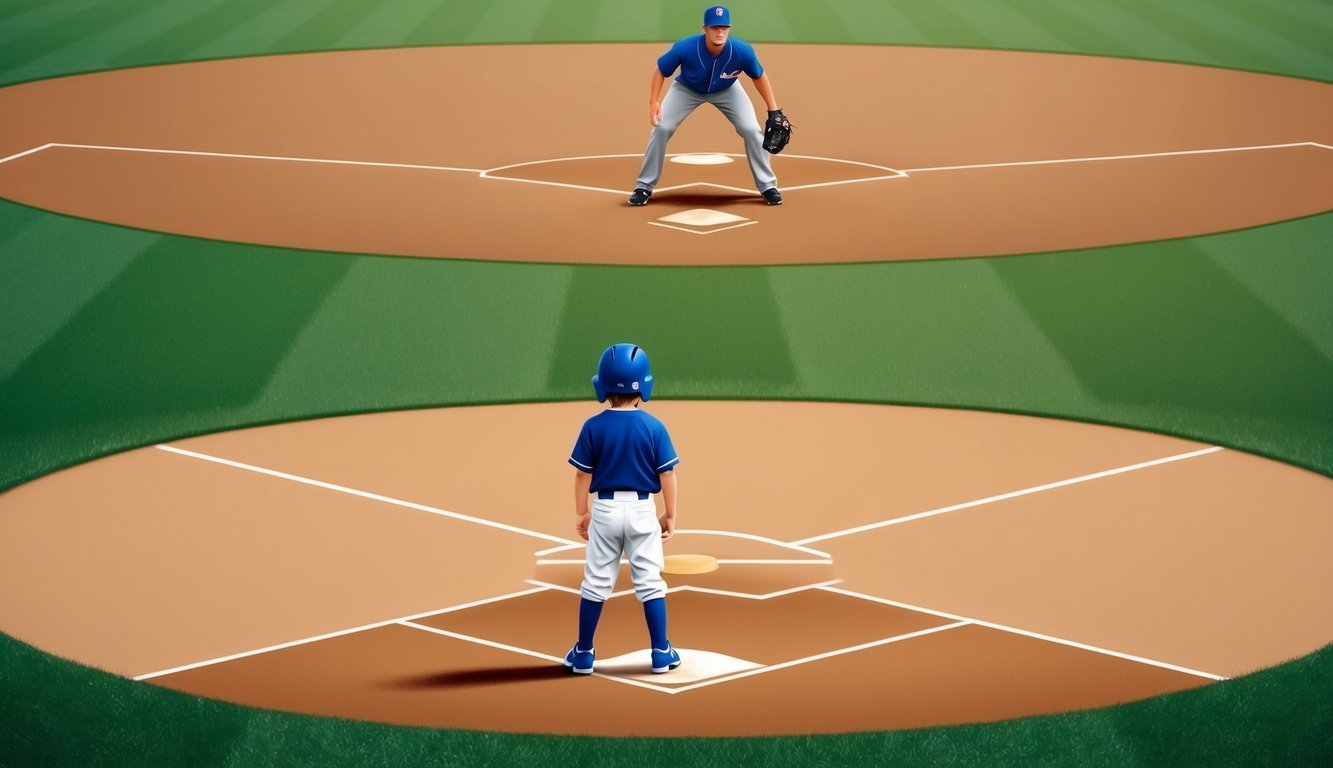Baseball is a game of precision, and one crucial element that changes as players grow is the pitching mound distance.
Young players start closer to home plate, gradually increasing the distance as they advance through age groups and skill levels.
This progression helps develop proper mechanics and arm strength while reducing injury risks.
For youth baseball, pitching distances typically range from 40 feet for the youngest players to 60 feet 6 inches for older teens and adults. The exact distance varies by league and age division.
For example, 8-10 year olds often pitch from 46 feet, while 11-12 year olds may throw from 50-52 feet.
Understanding these distances is essential for coaches, parents, and young pitchers.
It impacts everything from field setup to practice drills and equipment choices.
As players progress, they’ll need to adapt their techniques to maintain accuracy and power over longer distances.
Understanding the Basics

The pitching mound is a crucial element in baseball, affecting both gameplay and player performance.
Its dimensions and specifications vary based on the age group and league level.
Pitching Mound Dimensions and Specifications
The pitching mound is typically a circular raised area in the center of the infield.
Its diameter measures 18 feet, with the pitcher’s plate (or rubber) positioned at the center.
The rubber is a white slab, 6 inches by 24 inches in size.
For Major League Baseball, the distance from the front of the rubber to the back point of home plate is 60 feet 6 inches.
This measurement is essential for maintaining consistent gameplay.
Youth leagues adjust these dimensions to suit different age groups.
For example, Little League divisions use a 46-foot distance for ages 12 and under.
Intermediate divisions may use a 50-foot distance.
The Role of a Pitcher
A pitcher’s primary job is to throw the ball from the mound towards home plate, attempting to get batters out.
They stand on the rubber when delivering pitches, using various techniques to control speed, movement, and accuracy.
Pitchers must adapt to different mound heights and distances as they progress through age groups.
This gradual increase helps young players develop proper mechanics and arm strength safely.
The pitcher’s position is physically demanding, requiring a combination of skill, strategy, and endurance.
Mastering the art of pitching involves understanding how to use the mound’s elevation to generate power and create deception in their throws.
Pitching Distances for Different Age Groups

Pitching distances in baseball vary significantly across age groups, accommodating players’ physical development and skill levels.
These distances are carefully calibrated to ensure fair competition and player safety.
Youth Baseball: Little League and Beyond
Little League pitching distances start at 46 feet for ages 9-12.
This shorter distance helps young pitchers develop accuracy and confidence.
For even younger players, ages 7-8, the mound is often set at 40 feet from home plate.
As players grow, distances increase.
Cal Ripken Baseball, for ages 11-12, uses a 50-foot pitching distance.
Babe Ruth League’s 13-15 division moves the mound back to 54 feet.
Some youth leagues use a gradual approach:
- Ages 9-10: 46 feet
- Ages 11-12: 50 feet
- Ages 13-14: 54 feet (with 80-foot basepaths)
These incremental changes help players adapt as they progress through age levels.
High School to College Baseball
High school and college baseball both use the regulation 60 feet, 6 inches from the pitcher’s rubber to home plate.
This distance remains consistent for all high school divisions and NCAA baseball.
The transition to this distance is significant for young pitchers.
It requires increased arm strength and refined mechanics.
Coaches often work closely with pitchers to help them adjust to the longer distance.
Some key points for this level:
- Mound height: 10 inches
- Pitching rubber: 24 inches long
- Bullpen areas: Often mirror game mound dimensions
Transition to Major League Baseball
Major League Baseball uses the standard 60 feet, 6 inches pitching distance.
This has been the official distance since 1893.
The consistency between high school, college, and MLB helps smooth the transition for advancing players.
Other MLB pitching mound specs:
- Diameter: 18 feet
- Slope: 1 inch per foot
- Front edge: 6 inches in front of rubber
While the distance remains the same, MLB mounds are often more finely tuned.
Groundskeepers maintain precise slopes and firmness to meet league standards and pitcher preferences.
Preparing the Pitching Mound

A well-constructed and maintained pitching mound is crucial for player safety and performance.
Proper preparation ensures consistent footing and accurate pitching distances across different age groups and skill levels.
Materials and Equipment for Mound Construction
Building a regulation pitching mound requires specific materials and tools.
Clay-based soil is the preferred material for its durability and ability to hold shape.
A typical mound needs about 8-10 tons of this soil.
Essential equipment includes:
- Rake
- Shovel
- Tamp
- Measuring tape
- Slope board
- Level
The mound’s shape is critical.
It should have a 10-inch height for most levels, with a gradual slope.
The pitching rubber must be securely anchored at the proper distance from home plate.
A table level helps ensure the correct slope:
| Distance from rubber | Height |
|---|---|
| 6 inches | 6″ |
| 12 inches | 4″ |
| 18 inches | 2″ |
Maintenance: Keeping the Mound Safe and Pitch-Ready
Regular maintenance preserves the mound’s integrity and safety.
Daily tasks include filling holes, tamping loose areas, and leveling the landing zone.
Watering the mound is crucial.
It prevents cracking and maintains proper moisture content.
A light mist before games helps settle dust and improve footing.
After each game or practice:
- Fill and tamp pitcher’s holes
- Rake and smooth the slope
- Cover the mound to protect from weather
Periodically check the pitching rubber’s position and height.
Adjust if needed to maintain accurate pitching distances for different age groups.
Proper shoes with non-metal cleats help preserve the mound’s surface.
Encourage players to avoid unnecessary wear during practice.
Development and Safety for Young Pitchers

Proper development and safety practices are crucial for young pitchers.
Balancing skill improvement with injury prevention helps ensure long-term success on the mound.
Understanding Pitch Counts and Rest Periods
Coaches should implement pitch count limits and mandatory rest periods for young pitchers.
These measures help prevent arm fatigue and reduce injury risks.
For players under 14, it’s advisable to throw no more than 75 pitches per game.
Rest periods between outings are equally important.
A pitcher who throws 1-20 pitches should rest for one day, while 21-35 pitches require two days of rest.
Coaches must monitor pitch counts during games and practices.
They should also teach players to recognize signs of fatigue.
It’s crucial to avoid having young pitchers throw in multiple games on the same day.
Training and Practice for Skill Improvement
Young pitchers can enhance their skills through structured training programs.
Regular practice sessions on a game mound help develop proper mechanics and improve accuracy.
Pitching machines and batting cages offer controlled environments for refining techniques.
Coaches should focus on teaching a variety of pitches, starting with fastballs and change-ups.
As players progress, they can introduce more complex pitches.
Proper footwork and athleticism are essential components of pitching development.
Working with catchers during practice helps pitchers build timing and rhythm.
Drills that target muscle memory can improve consistency.
It’s important to balance mound work with other baseball activities to maintain overall athleticism.
Incorporating various training elements, such as fielding and batting practice, can enhance a pitcher’s overall game.
Utilizing baseball hitting drills for all levels ensures that players develop a comprehensive skill set, which contributes to their effectiveness on the mound.
By focusing on both pitching techniques and batting fundamentals, athletes can foster a well-rounded approach that translates into improved performance during games.
Age-Specific Playing Field Modifications

Baseball fields are adapted to suit different age groups, ensuring players develop skills appropriate for their level.
These modifications include adjusting pitching distances and mound heights.
League Standard Field Adjustments
Little League fields for ages 9-12 use 60-foot base paths and a 46-foot pitching distance.
The outfield fence typically ranges from 200 to 225 feet.
PONY League divisions have varying dimensions:
- Mustang (ages 9-10): 50-foot pitching distance
- Bronco (ages 11-12): 50-foot pitching distance
- Pony (ages 13-14): 54-foot pitching distance
- Colt/Palomino (ages 15-19): 60 feet, 6 inches
Senior League adopts the standard MLB pitching distance of 60 feet, 6 inches.
Some leagues offer transitional options, like the Intermediate (50/70) division with a 50-foot pitching distance and 70-foot base paths.
Customizing Portable Pitching Mounds
Portable pitching mounds offer flexibility for practice and games.
They come in various sizes to match age-specific requirements:
- 10U: 6 inches high, 8 feet wide
- 12U: 6 inches high, 9 feet wide
- 13+ and adult: 10 inches high, 10 feet wide
These mounds can be adjusted for different age groups by adding or removing material.
Some models also feature removable pitching rubbers to easily change distances.
When selecting a portable mound, consider:
- Durability for outdoor use
- Non-slip surfaces for safety
- Ease of transport and setup
Portable mounds allow teams to practice on regulation heights even when field space is limited.
